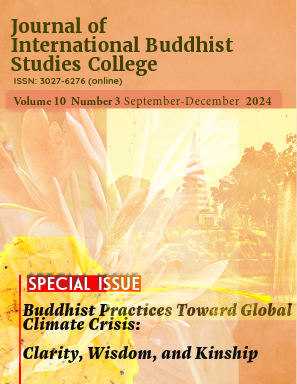The Model of Sukha Community According to Buddhist Peaceful Means
Main Article Content
Abstract
This research explores the Model of Sukha Community through Buddhist peaceful means, focusing on three objectives: 1) to analyze the concepts and theories of sukha (happiness) within communities, 2) to examine Buddhist peaceful methods for fostering happiness, and 3) to develop and propose a practical model for community well-being inspired by Buddhist teachings. The study employs a qualitative methodology, integrating documentary analysis, in-depth interviews, and focus group discussions.
The findings reveal that the Sukha Community Model is a structured framework rooted in Buddhist principles, particularly the Saraniya-dhamma, designed to foster communal harmony and enduring happiness. The model comprises five core elements: Serenity, Understanding, Kindness, Harmony, and Alignment. These elements represent a holistic approach that integrates mindfulness, ethical living, and interpersonal compassion to address societal challenges. By combining traditional Buddhist teachings with modern approaches, the model provides practical methods for cultivating mutual respect, reducing conflicts, and enhancing social cohesion.
The Sukha Community Model offers actionable strategies, such as promoting loving-kindness (metta), compassion (karuna), and shared ethical values, which are essential for transforming societal suffering into collective well-being. This synthesis of ancient wisdom and contemporary practices makes the model a valuable tool for creating thriving communities where individuals and groups experience interconnectedness and happiness. Through its emphasis on inner peace, moral integrity, and communal support, the Sukha Community Model demonstrates the enduring relevance of Buddhist teachings in building sustainable and harmonious societies.
Article Details
The Journal of TCI is licensed under a Creative Commons Attribution-NonCommercial-NoDerivatives 4.0 International (CC BY-NC-ND 4.0) licence unless otherwise stated. Please read our Policies page for more information on Open Access, copyright and permissions.
References
Bhikkhu Bodhi. (Ed.). (2005). In the Buddha's words: An anthology of discourses from the Pali Canon. Simon and Schuster.
Bhikkhu Bodhi. (2012). The Numerical Discourses of the Buddha: A Translation of the Anguttara Nikaya. Wisdom Publications.
Bok, S. (2010). Exploring Happiness: From Aristotle to Brain Science. Yale University Press.
Brown, K. W., & Ryan, R. M. (2003). The benefits of being present: Mindfulness and its role in psychological well-being. Journal of Personality and Social Psychology, 84(4), 822–848. https://doi.org/10.1037/0022-3514.84.4.822
Buddhadāsa Bhikkhu. (2014). Happiness & Hunger. The Buddhadāsa Indapañño Archives & Liberation Park.
Byron, T. (2010). The Dhammapada: The sayings of the Buddha. Random House.
Gethin, R. (2008). The Foundations of Buddhism. Oxford University Press.
Grossman, P., & Van Dam, N. T. (2011). Mindfulness, by any other name: Trials and tribulations of sati in Western psychology and science. Contemporary Buddhism, 12(1), 219-239.
Gyatso, T. (1998). The Art of Happiness: A Handbook for Living. Riverhead Books.
Hanh, T. N. (1999). The Heart of the Buddha's Teaching: Transforming Suffering into Peace, Joy, and Liberation. Broadway Books.
Hanh, T. N. (1987). Being Peace. Parallax Press.
Harvey, P. (2000). An Introduction to Buddhist Ethics: Foundations, Values and Issues. Cambridge University Press.
Harvey, P. (2013). An Introduction to Buddhism: Teachings, History and Practices. Cambridge University Press.
Helliwell, J. F., Layard, R., & Sachs, J. D. (2023). World Happiness Report 2023. Sustainable Development Solutions Network.
James, M. (2012). Happiness and The Art of Being. Michael D’Aleo Press.
Kabat-Zinn, J. (2003). Mindfulness-Based Interventions in Context: Past, Present, and Future. Clinical Psychology: Science and Practice, 10(2), 144–156.
King, S. B. (2021). Being Benevolence: The Social Ethics of Engaged Buddhism. University of Hawaii Press.
Lyubomirsky, S. (2007). The How of Happiness: A New Approach to Getting the Life You Want. Penguin.
Mahasi Sayadaw, (1998). Dhammacakkappavattana Sutta. Sukhi Hotu Dhamma Publication.
Nandamalabhivamsa, B. (2010). The Path of Happiness. Thit Sar Hla Press.
Payutto, P. A. (2018). Buddha Dhamma-the Law of Nature and Their Benefits to Life. BuddhaDhamma Foundation.
Piyasīlo. (1995). The Buddhist Way to Happiness: Theory and Practice. Sukhi Hotu Publications
Prentiss, C. (2006). Zen and the Art of Happiness. Power Press
Rahula, W. (2007). What the Buddha Taught. Grove Press.
Rahula, W, (1974). The Heritage of the Bhikkhu. Grove Press.
Ramkissoon, H. (2023). Perceived social impacts of tourism and quality-of-life: A new conceptual model. Journal of Sustainable Tourism, 31(2), 442–459. https://doi.org/ 10.1080/14693062.2018.1551187
Ricard, M. (2015). Happiness: A Guide to Developing Life’s Most Important Skill. Little, Brown and Company.
Sangasumana, P. (2019). The Buddhist perspective on measuring well-being and happiness in sustainable development. International Journal of Multidisciplinary Research and Development, 6(3), 243–248.
See, H. (2022). The Two Faces of Gross National Happiness: Can Bhutan’s Nation-Building Strategy Also Be a Sustainable Alternative Development Paradigm? Journal of Contemporary Asia, 52(3), 452–470. https://doi.org/10.1080/00472336.2021.1933139
Shakya, R. P. (2019). Four Sources of Happiness in Buddhism. Journal of Buddhist Studies.
Studies (CBS), Mahasubodhayon Monastery.
Venkatraja, B. (2023). Integrating economic growth with the environmental intensity of human well-being: Evidence from Bhutan. Climate and Development, 15(8), 704–716. https://doi.org/10.1080/17565529.2022.2150046
Walshe, M. (trans.). (1995). The Long Discourses of the Buddha: A Translation of the Digha Nikaya. Wisdom Publications.
Yeshey, K., Ford, R. M., Keenan, R. J., & Nitschke, C. R. (2024). Religious beliefs and wildlife value orientations influence tolerance of wildlife impacts in Bhutan. Human Dimensions of Wildlife, 29(3), 300–318. https://doi.org/10.1080/10871209.2023. 2211723


